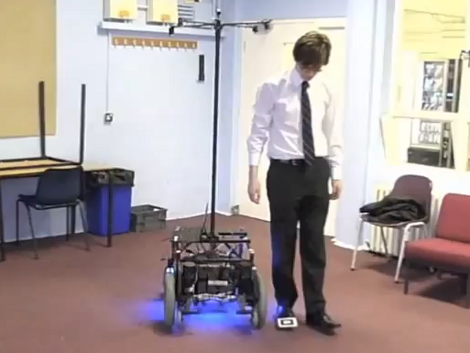[Tom Ladyman] is making the case that a robot can take the place of a guide dog. According to his presentation, guide dogs cost about £45,000 (around $70k) to train and their working life is only about six years. On the other hand, he believes that this robot can be put into service for about £1,000 (around $1500). The target group for the robots is blind and visually impaired people. This makes since, because the robot lacks a dog’s ability to assist in other ways (locating and returning items to their companion, etc.). The main need here is independent travel.
He starts with the base of an electric wheelchair — a time-tested and economy-of-scale platform. The robot navigates based on images from four downward facing cameras mounted on the pole seen above. The X on the top of the pole allows for a much wider range of sight. The robot identifies its companion via a tag on their shoe, but it’s got another trick up its sleeve. The cameras feed to a set of four BeagleBoards which work together to process them into a 3D map at about 12 FPS, allowing for obstacle avoidance.
Check out the video after the break for a bit more information. The 3D guidance system is also explained in detail at the link above.
Continue reading “Can A Robot Be A Safe And Cost-effective Alternative To Guide Dogs?”












